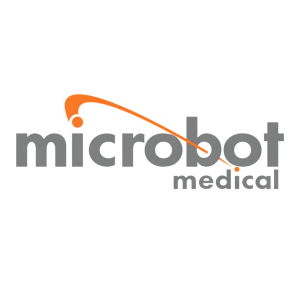Microbot Medical and Emory University to Evaluate the Future Autonomous Capabilities of the LIBERTY® Endovascular Robotic Surgical System
Rhea-AI Summary
Microbot Medical (Nasdaq: MBOT) has partnered with Emory University to explore autonomous robotics in endovascular procedures. The collaboration, led by Dr. Amir Pourmorteza, aims to integrate the LIBERTY® Endovascular Robotic Surgical System with imaging technology for autonomous endovascular procedures.
This initiative, known as Project Trita, combines CT-guidance, artificial intelligence, and medical robotics. The goal is to standardize outcomes, improve efficiencies, reduce radiation exposure, and democratize access to top-level healthcare. Microbot Medical's CEO, Harel Gadot, envisions this integration as a step towards creating an autonomous robotic system for endovascular procedures, potentially benefiting millions of patients globally.
Positive
- Partnership with Emory University to explore autonomous robotics in endovascular procedures
- Potential to standardize outcomes and improve healthcare access
- Integration of LIBERTY® system with imaging technology for autonomous procedures
Negative
- None.
News Market Reaction 1 Alert
On the day this news was published, MBOT declined 2.75%, reflecting a moderate negative market reaction.
Data tracked by StockTitan Argus on the day of publication.
The evaluation phase will explore the potential of integrating robotics, procedure planning and navigation into a single autonomous system
BRAINTREE, Mass., Aug. 01, 2024 (GLOBE NEWSWIRE) -- Microbot Medical Inc. (Nasdaq: MBOT) today announced it has entered into an agreement with Emory University, which will allow the parties to evaluate and explore the potential for a future collaboration in connection with autonomous robotics in endovascular procedures. Under the terms of the agreement, Emory University will assume the responsibility of exploring the feasibility of integrating the LIBERTY® Endovascular Robotic Surgical System with an imaging system to create an autonomous robotic system for endovascular procedures. Amir Pourmorteza, PhD, Assistant Professor in the Department of Radiology and Imaging Sciences at Emory University Winship Cancer Institute, and Department of Biomedical Engineering at Georgia Institute of Technology, will lead the evaluation under Project Trita.
“Autonomous robotics has the potential to standardize outcomes, improve efficiencies, reduce radiation exposure, and democratize access to top-level healthcare,” commented Dr. Pourmorteza. “Project Trita merges CT-guidance, artificial intelligence, and medical Robotics. I am excited to work with Microbot Medical on this project.”
“Our vision for the future of endovascular robotics includes autonomous capabilities, which has the potential to standardize endovascular procedures and improve access to benefit millions of patients globally. We believe LIBERTY® can be integrated with imaging, planning and navigation software to ultimately create an autonomous robotic system that can be used in endovascular procedures,” said Harel Gadot, CEO, President and Chairman of Microbot Medical. “We’re excited to work with Dr. Pourmorteza who is a leader in this space and we believe he shares a similar vision.”
About Microbot Medical
Microbot Medical Inc. (NASDAQ: MBOT) is a clinical- stage medical device company that specializes in transformational micro-robotic technologies, with the goals of improving clinical outcomes for patients and increasing accessibility through the natural and artificial lumens within the human body.
The Investigational LIBERTY® Endovascular Robotic Surgical System aims to improve the way surgical robotics are being used in endovascular procedures today, by eliminating the need for large, cumbersome, and expensive capital equipment, while reducing radiation exposure and physician strain. The Company believes the LIBERTY® Endovascular Robotic Surgical System’s remote operation has the potential to be the first system to democratize endovascular interventional procedures.
Further information about Microbot Medical is available at http://www.microbotmedical.com.
Safe Harbor
Statements to future financial and/or operating results, future growth in research, technology, clinical development, and potential opportunities for Microbot Medical Inc. and its subsidiaries, along with other statements about the future expectations, beliefs, goals, plans, or prospects expressed by management, constitute forward-looking statements within the meaning of the Private Securities Litigation Reform Act of 1995 and the Federal securities laws. Any statements that are not historical fact (including, but not limited to statements that contain words such as “will,” “believes,” “plans,” “anticipates,” “expects” and “estimates”) should also be considered to be forward-looking statements. Forward-looking statements involve risks and uncertainties, including, without limitation, market conditions, risks inherent in the development and/or commercialization of the LIBERTY® Endovascular Robotic Surgical System, the outcome of its studies to evaluate the LIBERTY® Endovascular Robotic Surgical System, uncertainty in the results of pre-clinical and clinical trials or regulatory pathways and regulatory approvals, including whether the Company’s pivotal study in humans is successful, any failure or inability to recruit physicians and clinicians to serve as primary investigators to conduct regulatory studies which could adversely affect or delay such studies, disruptions resulting from new and ongoing hostilities between Israel and the Palestinians and other neighboring countries, any lingering uncertainty resulting from the COVID-19 pandemic, need and ability to obtain future capital, and maintenance of intellectual property rights. Additional information on risks facing Microbot Medical can be found under the heading “Risk Factors” in Microbot Medical’s periodic reports filed with the Securities and Exchange Commission (SEC), which are available on the SEC’s web site at www.sec.gov. Microbot Medical disclaims any intent or obligation to update these forward-looking statements, except as required by law.
Investor Contact:
Michal Efraty









